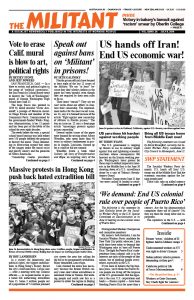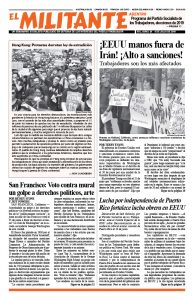The U.S. government is stepping up threats to use its military might against Iran and tightening economic sanctions whose consequences fall heaviest on the Iranian working people. Washington’s latest pretext for these steps to defend imperialist interests in the Middle East is the June 20 shooting down of a U.S. surveillance drone by a unit of Tehran’s Revolutionary Guard.
President Trump wrote June 21 that “we were cocked & loaded to retaliate last night on 3 different sites” inside Iran, but called it off with 10 minutes to spare. He said he was told by the Pentagon these strikes would “kill 150 Iranians,” and that he had decided such an attack was “disproportionate” to the downing of a pilotless drone.
Hours later the president told NBC, “I’m not looking for war,” but then threatened, “If there is, it’ll be obliteration [of Iran] like you’ve never seen before.”
The shootdown came three days after Washington announced the deployment of another 1,000 U.S. troops to the region. This comes on top of the more than 20,000 soldiers and an arsenal of warships, bombers and land and seaborne missiles it already stations across the Middle East to defend the U.S. rulers’ profitable oil properties and other economic and political interests.
At the same time as Washington tightens its noose on Iran, squeezing workers and farmers there, it is demanding that the Iranian government agree to new negotiations.
The Pentagon sent additional troops after two oil tankers, one Norwegian-owned and the other Japanese-owned, were attacked June 13 in the Gulf of Oman. Washington says the attacks, which damaged the ships without seriously injuring anyone, were orchestrated by Tehran. The attacks came as Japanese Prime Minister Shinzo Abe was meeting with leaders in Tehran in an attempt to “mediate” in the conflict on behalf of Washington.
Acting Secretary of Defense Patrick Shanahan said the 1,000 troops were needed to counter the “hostile behavior of Iranian forces and their proxy groups,” referring to militias that Tehran arms and trains in Lebanon, Iraq, Syria and Yemen to advance its counterrevolutionary course in the region.
The Trump administration hopes its military threats and economic punishment can force Iran’s rulers to rein in the militias and end programs enabling the development of nuclear weapons and long-range missiles.
Divisions among Iran rulers
There are divisions within both the Iranian regime and the Revolutionary Guard, including about the wisdom of shooting down the U.S. drone. The New York Times said that at least one Revolutionary Guard senior commander and other government leaders were “frustrated or furious with the tactical commander who made the decision to shoot down the American drone.”
The Revolutionary Guard, which operates separately from the government armed forces, has been at the forefront of efforts to extend the bourgeois clerical regime’s influence across the region. Its elite Quds Force, officially responsible to Supreme Leader Ayatollah Ali Khamenei, contains factions that operate to advance their own rival interests within the clerical hierarchy and state bureaucracy. Some are itching for an armed conflict with Washington.
The Guard Corps has 100,000 soldiers, controls a militia of another 600,000, and has its own air force and navy, which is larger than Iran’s regular navy. It controls its own business empire, which includes construction and running the national airport.
The U.S. government designated the Revolutionary Guard a “terrorist organization” in April, imposing sanctions on its officials.
New economic pounding
More sanctions targeting Khamenei, government officials and eight commanders of the Iranian Revolutionary Guard were imposed by Washington June 24, with bipartisan support in Congress.
The punishing economic strictures worsen the deteriorating conditions working people in Iran face. The annual inflation rate topped 50% last month, its highest level since 1980. Over a quarter of all young people are unemployed.
Working people also bear the toll from the destructive wars Iran’s capitalist rulers are waging abroad. Tehran presses workers and farmers in Iran, as well as from Afghanistan, Pakistan and elsewhere into “volunteering” to join militias, which it uses to intervene in the region’s conflicts.
Politicians and commentators across the bourgeois spectrum in U.S. politics seek to draw an equal sign between today’s reactionary Iranian clerical regime and the 1979 Iranian Revolution — in which millions of working people overthrew the hated U.S.-backed shah of Iran. But this regime is in fact a product of a bloody counterrevolution in the early 1980s that pushed back many gains working people had made over the first few years following the 1979 popular upsurge.
As the U.S. rulers ratchet up their pressure, the Iranian rulers continue to advance their counterrevolutionary foreign military operations. Iranian military commanders proposed June 24 to the Iraqi government new joint military exercises between Tehran-organized forces there and the Iraqi army, which also carries out joint operations with the more than 5,000 U.S. troops stationed in Iraq.

